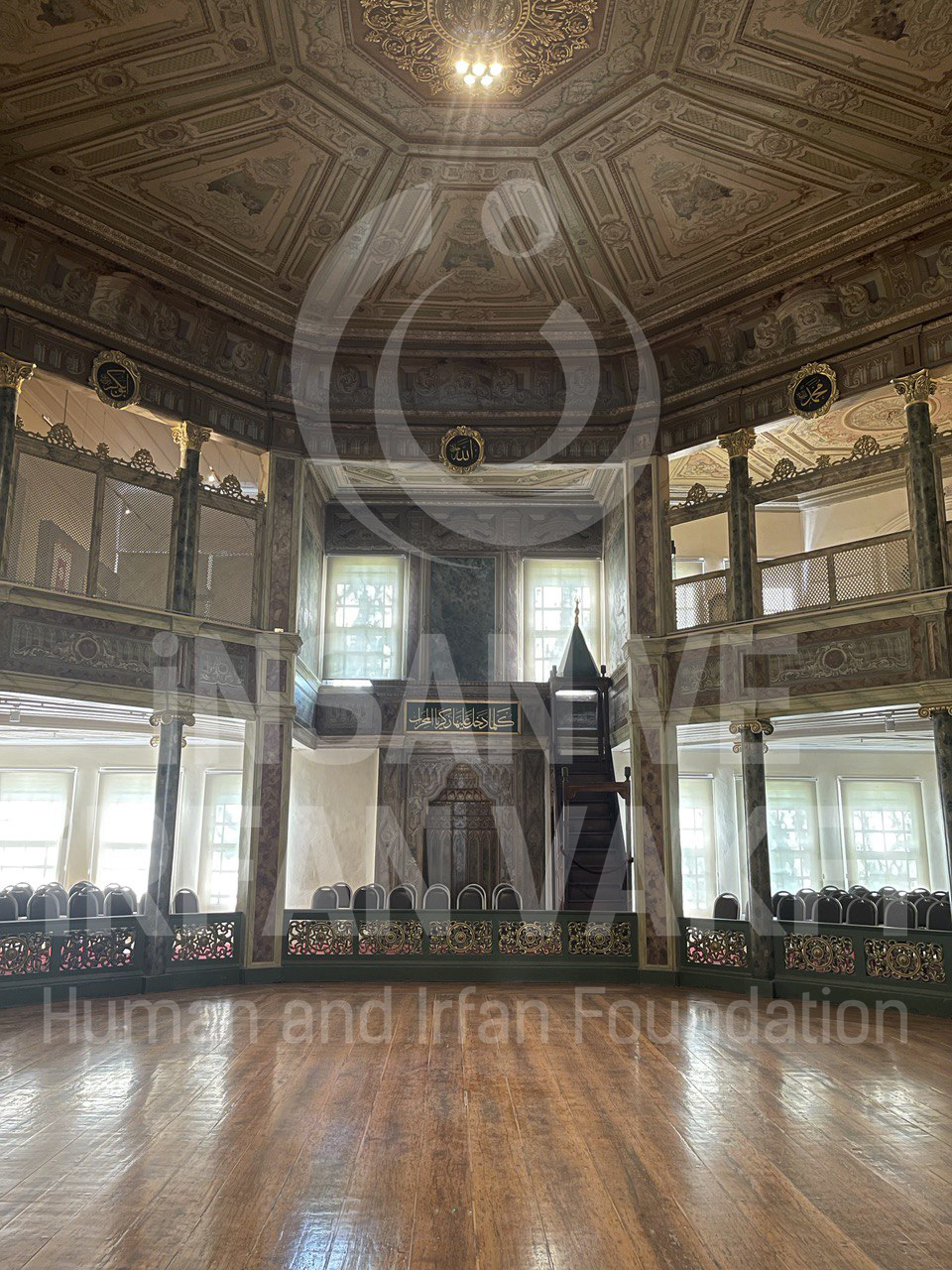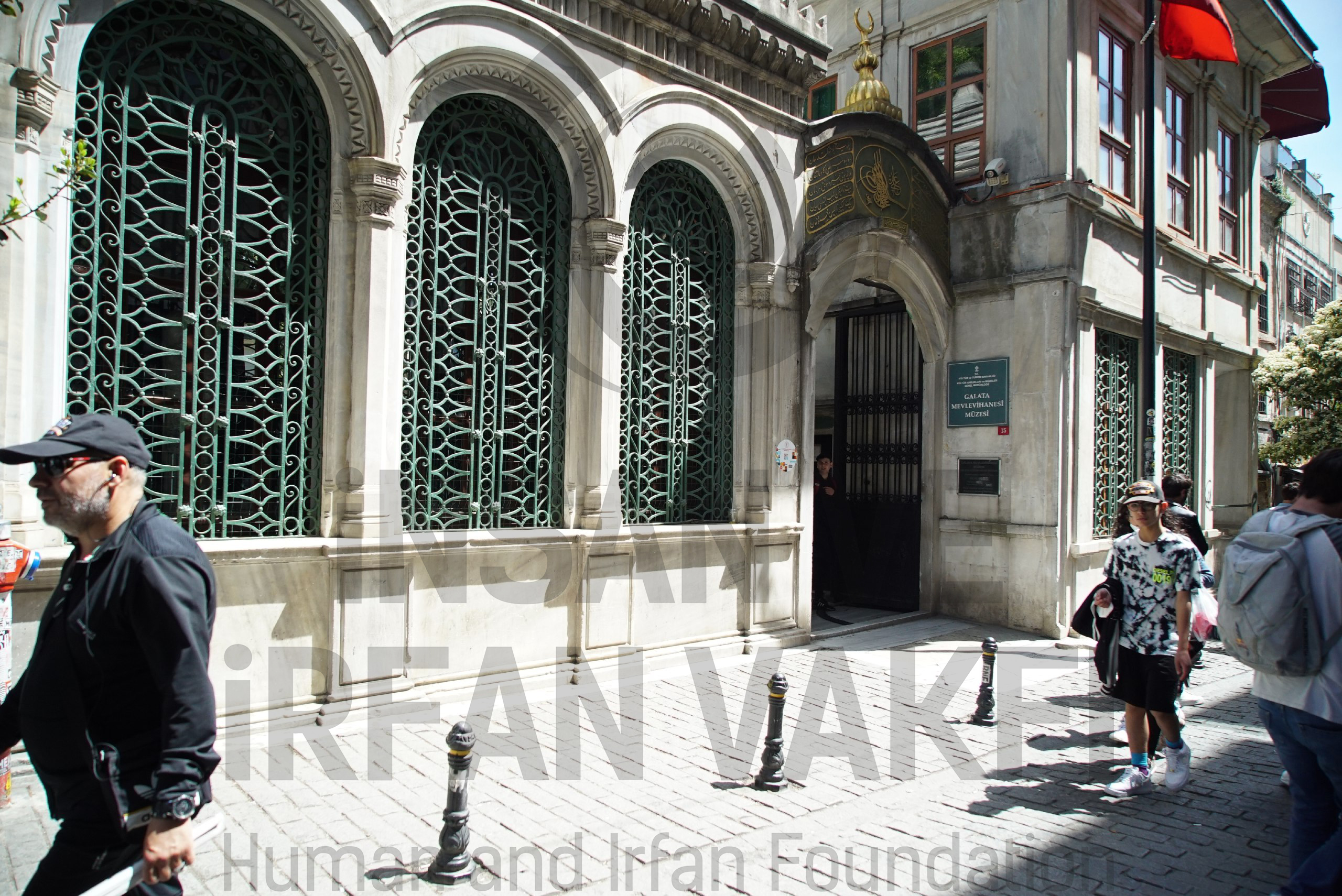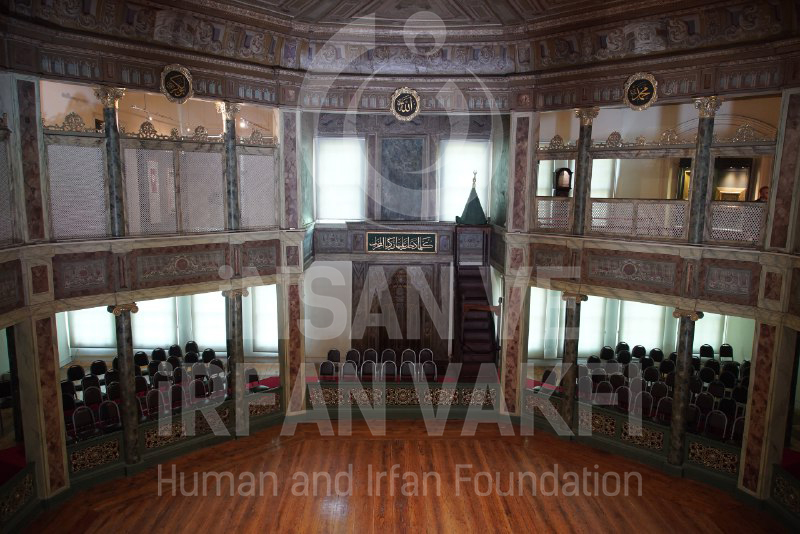History of Galata Mevlevi Lodge
GALATA MEVLEVÎHÂNESİ
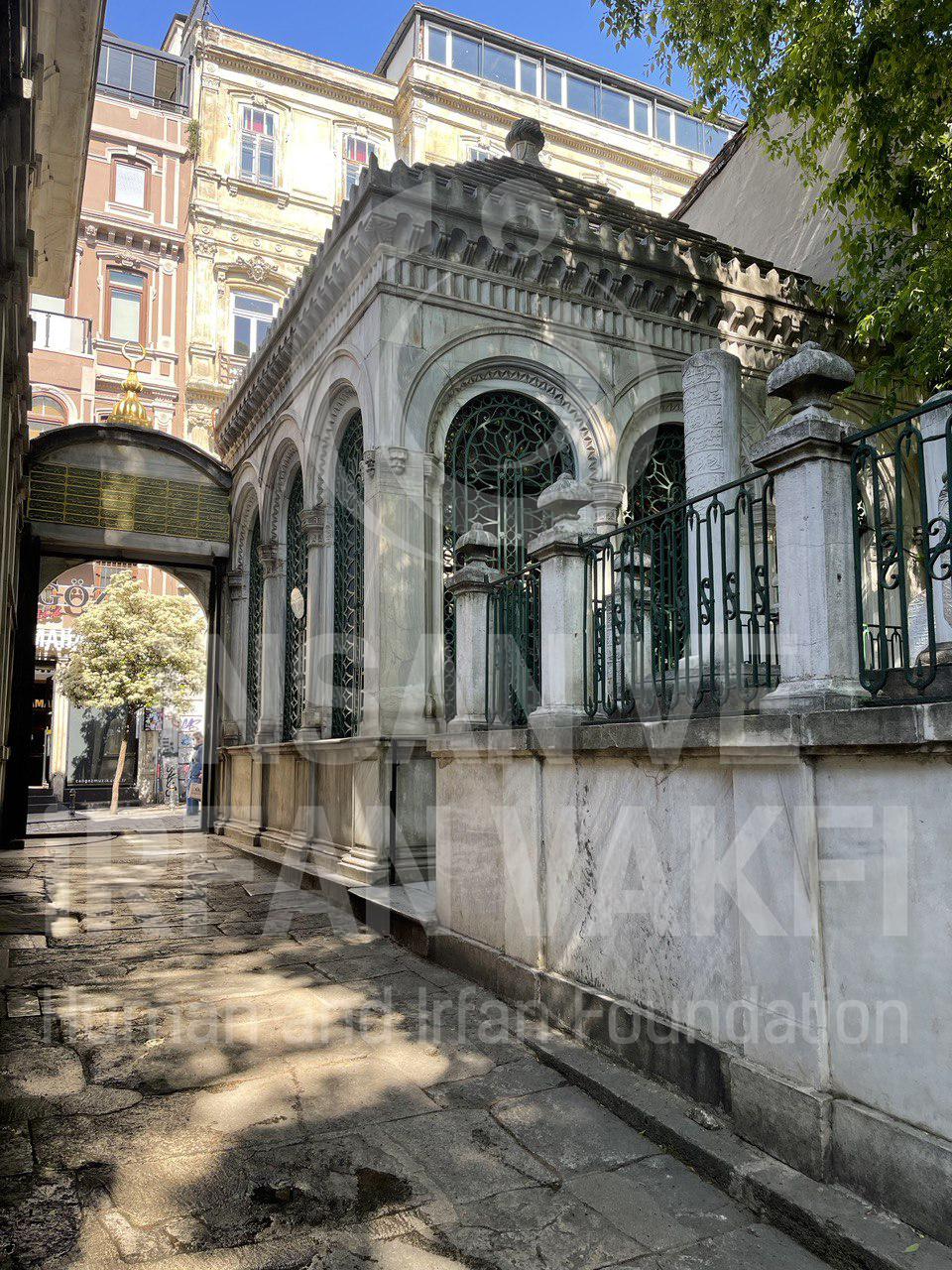
Galata Mevlevi Lodge was built in 1491 on the ruins of the Roman-Byzantine Theodoros Monastery on a part of the hunting farm by Iskender Pasha, one of the statesmen of Fatih Sultan Mehmed Khan and Bâyezid II.
It was the central lodge of the first Mevlevi dervishes in Istanbul. The days when the lodge's dhikr ceremony is performed (mukâbele days) are Tuesday and Friday. [1]
According to Evliya Çelebi's account, Semâi Mehmed Dede, a guest of Iskender Pasha and the grandson of the Pir Mevlana Jalaluddin Rumi, used a part of the farm as a tekke and thus the first Mevlevi lodge was established in Istanbul. Semai Mehmed Dede was also known as Divane Mehmed Chelebi.
The second sheikh of the Galata Mevlevi lodge was Safaî Dede from Sinop, who was the clerk of the foundation of Iskender Pasha's farm and later became a disciple and khalifa of Semâi Mehmed Chelebi. [2]
In the earthquake of 1509, Galata Mevlevi Lodge was damaged. Galata Mevlevi Lodge was abandoned for a while after the first three sheikhs, and after the death of the fourth sheikh, Mesnevîhan Mahmud Dede, it became derelict and ruined. It served as a Khalwati lodge for a while and was used as a madrasah for a while.
In the 17th century, Sırrı Abdi Dede, who was appointed by the Chelebi in Konya, proved that the building had previously been a Mevlevi lodge and reclaimed the building and the foundation deed. In 1608, a major repair was carried out at the Mevlevi lodge.[3]
Galata Mevlevi lodge was destroyed in the great Tophane fire of 1765, and the sultan of the time, Mustafa III, appointed Osman Efendi of Yenişehirli as the building supervisor and had it rebuilt. The other renovation, in which significant changes were made to the layout of the Mevlevi lodge, was the work of Selim III Khan, a Mevlevî follower. After the famous dîvan poet Sheikh Galib, who was the sheikh of the Mevlevi lodge at the time of Selim III's accession to the throne, informed the Sultan that the Tekke was in need of repair with a petition attached to his poem "Kasîde-i Tannâne", Selim III renovated the buildings of the Mevlevi lodge in 1791-92. [4]
The Mevlevi lodge underwent many renovations, repairs and alterations in the 19th century. The first of these is the reconstruction activity carried out in 1819 by Hâlet Efendi, one of the famous figures of Mahmud II's reign. Hâlet Efendi had his own mausoleum, which is adjacent to the current sentence gate and the current sentence gate, consisting of a fountain, a fountain, a tailor shop, a library and a school, covered the courtyard with marble, repaired the cells, and rebuilt the mausoleum where Ankaravî Sheikh İsmâil Rusûhî Dede, the Mes̱nevî commentator of the Mevlevi lodge, and Sheikh Galib Dede were buried.[5]
The Mevlevi lodge suffered another fire in 1824 and the masjid, matbah-ı şerif (kitchen) and nine cells were destroyed. In the petition written by Sheikh Seyyid Kudretullah Dede addressed to the sadâret office in 1828, it is stated that although four years have passed since the fire, the dervishes are still sheltering in the tents and the tents are worn out and it is requested that the necessary action be taken. Mahmud Han II rebuilt the Mevlevi lodge in 1835, renovating the tents in response.
In 1847, Âdile Sultan, daughter of Mahmud II, had a cistern, fountain and laundry units added to the Mevlevi lodge. Abdülmecid Khan had the Hasan Aga Fountain in the courtyard repaired in 1851-52, the matbah-ı şerif (kitchen) was rebuilt the following year, and in 1859-60 the main building, which included the sema hall, selamlık (the portion of a house reserved for men) and cells, was rebuilt in its present form. In the second half of the 19th century, probably following the death of Kudretullah Dede and his burial in the open tomb built by Hâlet Efendi, a closed tomb was built in its place. The Mevlevi lodge underwent minor repairs during the reigns of Abdülhamid II and Mehmed Reşad V.[6]
After 1925, when the dervish lodges were closed, the main building of the Mevlevi lodge was used as a public house and the sebilküttâb as a police station. At one point, a primary school was planned to be built in the courtyard, but this was not realized. In 1945-1947, the municipality removed the eastern section of the cemetry on Şahkulu Bostanı Street and built Beyoğlu Marriage Office in its place, and in the meantime, the wooden tombs at the entrance of the sema hall, the harem section, the matbah-ı şerif (kitchen) and some other outbuildings were removed. [7]
After four years of extensive renovations, the Galata Mevlevi lodge was opened to visitors on December 27, 1975 under the name of the Divan Literature Museum. Restored with the contributions of the Istanbul 2010 European Capital of Culture Agency, the building is still used as a museum. [8]
Galata Mevlevi lodge sheikhs, their family members and some prominent members are buried in the mausoleum. The place where the graves of dervishes are located is the cemetry units, also known as "Hâmûşân" (people who are in silence). There are also the graves of sheikhs, their wives, kudümzen (drum player), neyzen (reed flute player) and poets with divan in the treasury of the Mevlevi lodge. [9]
There are two mausoleums in the garden of Galata Mevlevi lodge. One is the tomb of Halet Efendi, just to the left of the sentence gate, and the other is the tomb of Sheikh Galib a little further on. Halet Sait Efendi, Kudretullah Dede and his wife Emine Hanım, their son Ataullah Dede and Ubeydullah Dede, the sheikh of Thessaloniki Mevlevi lodge, are buried in Halet Efendi's mausoleum, while Ismail Ankaravi, Isa Dede, Selim Dede, Sheikh Galib Dede, Hüseyin Dede and Mehmed Ruhi Dede are buried in Sheikh Galib Efendi's mausoleum. Opposite the Halet Efendi Tomb is the Halet Efendi Library, in front of it is a fountain, there is a cistern between the two tombs, behind the tombs is a cistern, opposite the sentence gate is a sema hall and museum, and on the right side of the garden is a fountain built by Adile Sultan.
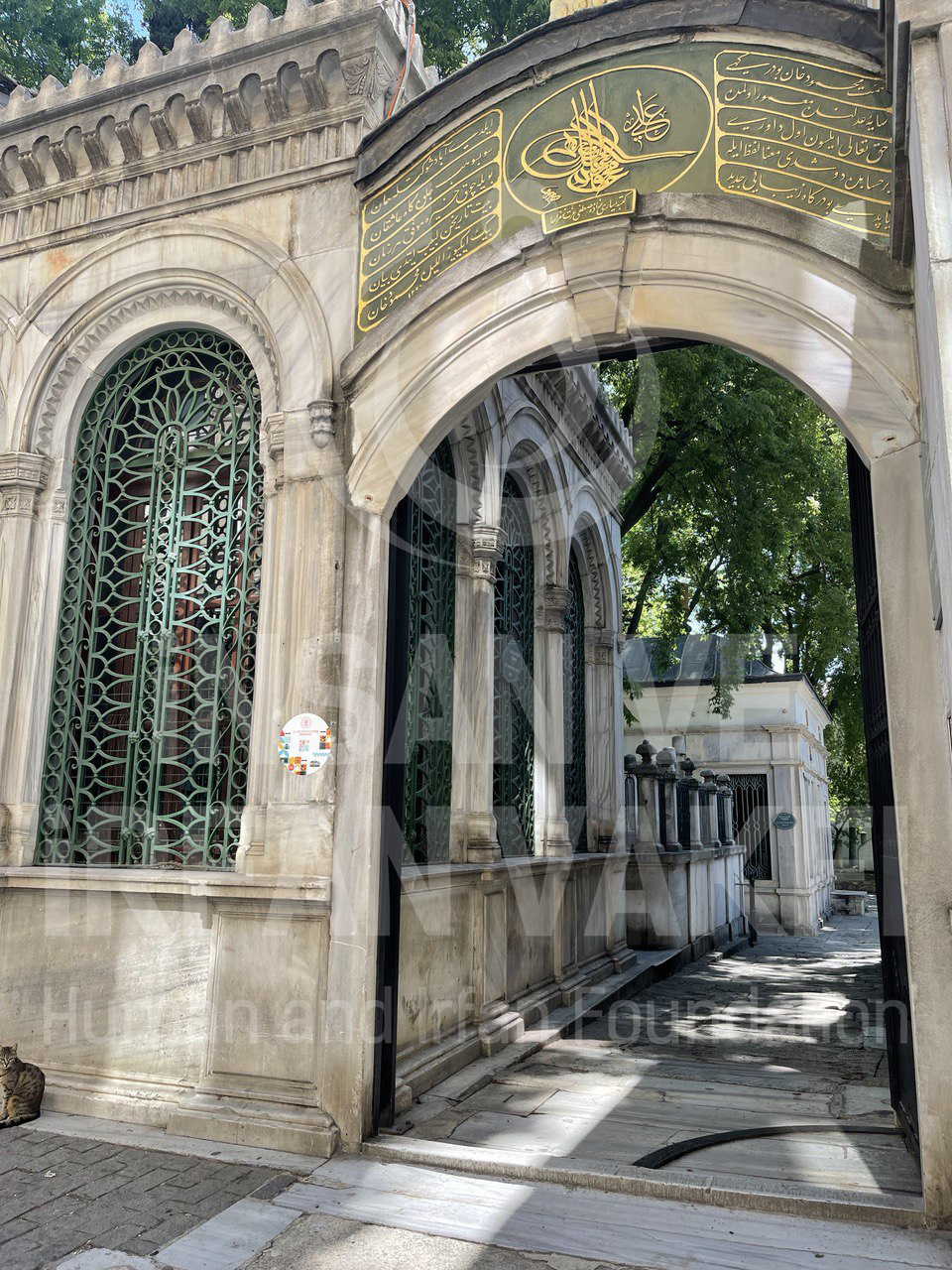
REFERENCES
- Dervişoğlu V. Ş. (2019) Fetih Sonrası İstanbul’da Mevlevî’liğin Tarihsel Süreci: Yenikapı Ve Galata Mevlevîhânesi Örnekleri, 32-35
-Erdoğan M. Mevlevi Kuruluşları Arasında İstanbul Mevlevihaneleri
- Uzluk Ş. (1943), Mevlâna’nın Ressamları, Konya Halkevi Aylık Kültür Dergisi, s. 23-36
- https://istanbultarihi.ist/173-galata-mevlevihanesi Safi Arpaguş Erişim Tarihi: 05.05.2022
- http://muze.semazen.net/content.php?id=00154 Erişim Tarihi: 05.05.2022
- https://islamansiklopedisi.org.tr/galata-mevlevihanesi M. Baha Tanman Erişim Tarihi: 05.05.2022
-http://www.kulturvarliklari.gov.tr/yazdir?A702E736908704E50E4BB8F5C205ABE7 Erişim Tarihi:10.05.2022
[1] https://istanbultarihi.ist/173-galata-mevlevihanesi
[2] Dervişoğlu V. Ş. (2019) Fetih Sonrası İstanbul’da Mevlevî’liğin Tarihsel Süreci: Yenikapı Ve Galata Mevlevîhânesi Örnekleri, 35
[3] Dervişoğlu V. Ş. (2019) Fetih Sonrası İstanbul’da Mevlevî’liğin Tarihsel Süreci: Yenikapı Ve Galata Mevlevîhânesi Örnekleri, 42
[4] https://istanbultarihi.ist/173-galata-mevlevihanesi
[5] https://istanbultarihi.ist/173-galata-mevlevihanesi
[6] https://islamansiklopedisi.org.tr/galata-mevlevihanesi
[7] https://istanbultarihi.ist/173-galata-mevlevihanesi
[8] https://istanbultarihi.ist/173-galata-mevlevihanesi
[9] http://muze.semazen.net/content.php?id=00154


